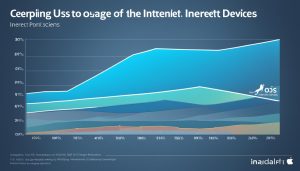Welcome to our in-depth exploration of the growing trend of web page size and its impact on user experience and website performance. In recent years, the average web page size has surpassed the 1MB mark, signaling a significant increase in the digital content we consume online.
This growth in average web page size has far-reaching implications. It affects not only the speed at which web pages load but also the overall user experience and website performance. As page sizes continue to expand, it becomes vital to understand the factors behind this growth and implement strategies to optimize web page size for better performance.
Throughout this article, we will examine the factors that have contributed to the growth of web page size, the impact it has on user experience and website performance, and practical strategies to optimize web page size and enhance digital experiences.
Factors Contributing to the Growth of Web Page Size
The growth of web page size can be attributed to various factors. Technological advancements, design trends, and the demand for richer content have all played significant roles in the increase in web page size. Let’s explore each of these factors in more detail.
1. Technological Advancements
Advancements in web technologies have allowed for more complex and interactive web pages. With the development of HTML5, CSS3, and JavaScript frameworks, web developers now have access to powerful tools and functionalities to create dynamic and visually appealing websites. However, these advancements often come with a trade-off in terms of increased file sizes, leading to larger web pages.
2. Design Trends
In recent years, there has been a shift towards more visually-driven and immersive web design. Websites are now incorporating high-resolution images, videos, animations, and other multimedia elements to engage users. While these design trends enhance the overall aesthetics and user experience, they also contribute to the growth of web page size.
3. Demand for Richer Content
As internet users’ expectations continue to rise, there is a growing demand for richer content. Websites strive to provide comprehensive information, interactive features, and personalized experiences to attract and retain users. This demand for content has resulted in larger web pages with multiple media files, elaborate layouts, and extensive functionalities.
Web page size has become a balancing act between providing engaging content and maintaining optimal performance. It’s essential for website owners and developers to find the right balance to ensure a seamless user experience.
By understanding these factors contributing to the growth of web page size, we can better grasp the challenges faced by website owners and developers in optimizing their sites for performance and user satisfaction.
| Factor | Description |
|---|---|
| Technological Advancements | Advancements in web technologies allow for more complex and interactive web pages but can result in larger file sizes. |
| Design Trends | The shift towards visually-driven design has led to the incorporation of high-resolution images, videos, and animations, increasing web page size. |
| Demand for Richer Content | User expectations for comprehensive information and interactive features have resulted in larger web pages with multiple media files and elaborate layouts. |
Impact on User Experience and Website Performance
The growing average web page size has a significant impact on both user experience and website performance. As file sizes increase, several key aspects of the user’s journey are affected, resulting in potential frustration and decreased satisfaction.
One major area impacted by larger file sizes is page load time. Loading a website with extensive content and large files can be a slow and cumbersome process. Users value efficiency and expect pages to load quickly, and when this expectation is not met, they may become impatient and abandon the site altogether. Slow load times also have a negative impact on search engine rankings, as search engines prioritize websites that offer a smooth and seamless user experience.
“The growing average web page size has made page load time a critical factor that directly affects user experience. Users want instant access to the information they seek, and if a page takes too long to load, they may lose interest and move on to another site.”
In addition to page load time, mobile browsing is another area heavily impacted by larger file sizes. Mobile devices often have limited processing power and data connectivity, making them more sensitive to the size of web pages. Users browsing on mobile devices may experience longer load times, increased data usage, and even decreased battery life. With the increasing prevalence of mobile browsing, optimizing web page size is crucial for maintaining a positive user experience across all devices.
“As mobile browsing continues to dominate internet usage, optimizing web page size for mobile devices is essential. Users expect websites to be fast and responsive on their smartphones, and larger file sizes can hinder their browsing experience, leading to frustration and disengagement.”
Furthermore, the impact of larger web page sizes extends beyond load times and mobile browsing. Overall user satisfaction is significantly influenced by the performance of a website. Users want a smooth and enjoyable browsing experience, free from lagging, stuttering, and delays. When web pages are cluttered with excessive content and large files, it can hinder navigation, impair functionality, and lead to a negative perception of the website as a whole.
Not only does web page size impact user experience, but it also affects website performance in terms of conversion rates. A slow or poorly performing website can result in missed opportunities for conversions, as users may navigate away before completing a purchase or filling out a form. A seamless, user-friendly website that loads quickly and smoothly is essential for maximizing conversion rates and driving business success.
Implications of Growing Web Page Size
| Impact | Description |
|---|---|
| Increased page load time | Longer loading times frustrate users and negatively affect search engine rankings. |
| Challenging mobile browsing | Larger file sizes hinder performance on mobile devices, leading to slower load times and increased data usage. |
| Diminished user satisfaction | Lagging, stuttering, and delays caused by large web page sizes impair navigation and functionality. |
| Lower conversion rates | Poor website performance can result in missed opportunities for conversions and hinder business success. |

Strategies to Optimize Web Page Size
As web page sizes continue to grow, it becomes crucial to optimize them for a seamless user experience and improved website performance. By implementing the right strategies, you can mitigate the negative effects of larger web page sizes. Here are some practical techniques:
1. Image compression: Images tend to be one of the main contributors to web page size. To optimize them, consider compressing images without compromising quality. Tools like TinyPNG and CompressJPEG can help reduce image file sizes without significant loss of visual appeal.
2. Lazy loading: Implementing lazy loading ensures that resources, such as images and videos, are loaded only when they become visible within the user’s viewport. This technique improves initial page load time and reduces the overall web page size as it prevents unnecessary resource loading.
3. Minification: Minifying your HTML, CSS, and JavaScript files removes unnecessary characters, like spaces and comments, reducing their size. Tools like Minifier or build tools like Gulp and Grunt can automate this process.
4. Content Delivery Networks (CDNs): Utilize CDNs to distribute your website’s static assets across multiple servers located worldwide. By doing so, users can access these assets from a server geographically closer to them, reducing latency and speeding up page load times.
Implementing these strategies will not only optimize web page size but also contribute to a faster, more enjoyable user experience. Remember, a faster website can greatly impact user engagement, search engine rankings, and conversion rates.




